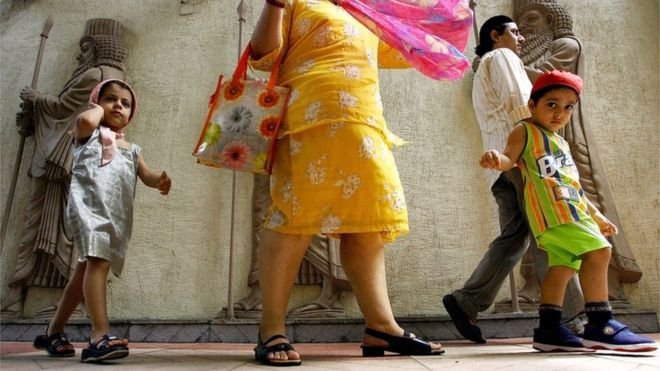Glimmer of hope at last for India’s vanishing Parsis
A jubilant Katy Gandevia passed around a box of celebratory sweets she had received in her office at the Tata Institute of Social Sciences in Mumbai.
“That,” she said, gesturing towards the sweets, “was to celebrate the birth of the 102nd baby.”
The baby in question had been born under the Jiyo Parsi scheme, a federal government initiative launched in 2013 to stem the decline of India’s Parsi population. Dr Gandevia is a senior member of this initiative.
Every baby born is a moment for celebration in the dwindling community that traces its ancestry to Zoroastrian refugees who landed on the coast of the western Indian state of Gujarat around the 8th Century.
Fleeing Islamic persecution in Persia, the new arrivals integrated with the local populations, while maintaining their distinctive ethnic identity. As a highly-educated and prosperous community, their success and influence have been far in excess of their size. And that size is always shrinking.
With each census, the number of Parsis has dropped, even as India’s population of 1.3 billion people has grown.
The latest 2011 census put the number of Indian Parsis at 57,264, a fall from 114,000 in 1941, and extinction has increasingly become a reality.
Jiyo Parsi is an ambitious plan to halt that.
For its first phase – which will conclude in a few months – the scheme received 100m rupees ($1.5m; £1.2m) to defray costs of fertility treatments for Parsi couples earning less than 2m rupees a year.
The campaign also sought to encourage Parsis to go forth and multiply through advertising, counselling and outreach efforts.
That flipped the script on family planning, a key part of Indian government policy for decades.
 When it was first announced in September 2013, the scheme quickly became both a headline and a punchline. Its quirky outreach included ad campaigns that urged couples to “Be responsible, don’t use a condom tonight” and told young men to cut the umbilical chord and marry because, “isn’t it time you broke up with your mom?”
When it was first announced in September 2013, the scheme quickly became both a headline and a punchline. Its quirky outreach included ad campaigns that urged couples to “Be responsible, don’t use a condom tonight” and told young men to cut the umbilical chord and marry because, “isn’t it time you broke up with your mom?”
But even though some objected that the campaign reduced women to their uteruses, it appeared to have made a dent.
“The scheme created an enthusiasm and a buzz,” Ms Gandevia told the BBC. “People were pessimistic but this has been a ray of hope.”
Most of the babies have been born in Mumbai, which has India’s largest concentration of Parsis. The number includes five pairs of twins and a roughly equal number of boys and girls.
One woman who declined to be identified claimed she had given up on having a child after repeated efforts which drained both her patience and money, but said that the financial assistance and counselling under the Jiyo scheme helped her conceive.
 Another woman said: “At the age of 41 when most women start experiencing the symptoms of menopause, I am experiencing the symptoms of a long-awaited pregnancy. At the end of every tunnel there is light.”
Another woman said: “At the age of 41 when most women start experiencing the symptoms of menopause, I am experiencing the symptoms of a long-awaited pregnancy. At the end of every tunnel there is light.”
Before she became a coordinator for the scheme, Ms Gandevia, a social scientist and Parsi herself, had studied this tightly-knit group for more than a decade.
She said the first cause for alarm was in 2001, when census figures showed a sharp drop.
“That was the time the bells should have started ringing. The writing was on the wall,” she said.
More than 30% of Parsis don’t marry, and an equal proportion are more than 60 years old. The total fertility rate for Parsis – the number of children a woman has – has dropped to 0.8. The average for India is 2.3, and 2.1 is the figure at which a population remains steady.




